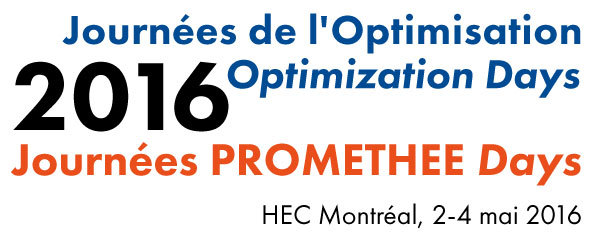
Journées de l'optimisation 2016
HEC Montréal, Québec, Canada, 2 — 4 mai 2016

MA9 Supply Chains
2 mai 2016 10h30 – 12h10
Salle: Pricewaterhouse Coopers
Présidée par Matthieu Gruson
4 présentations
-
 10h30 - 10h55
10h30 - 10h55Towards a regional logistical center: Design and Management
Our project aims to develop a profit maximisation model in order to identify the conditions ensuring the success of a forest regional logistic center comprising sorting yard operations and transportation coordination. A sensitivity analysis is also conducted to identify the factors affecting the most the profitability of such a center.
-
 10h55 - 11h20
10h55 - 11h20The selection of harvest areas and wood allocation problem – Multi-objective optimization
The tactical level of planning in forest management involves the selection of harvesting areas over a horizon of several years and allocation of logs to specific mills in order to fulfill certain demand. At this level, forest managers need to include several optimization criteria to fulfill new sustainable forest management policies. This study proposes a decision support system based on multi-objective optimization to enable an efficient tactical planning process of wood supply chain at the forest management unit level. Preliminary results from applying the model to a case study in the province of Québec will be presented and discussed.
-
 11h20 - 11h45
11h20 - 11h45Analysis of machine flexibility in lot sizing problems
In this paper, we study the value of machine flexibility in lot sizing models, analyse several machine flexibility configurations and determine what the best flexibility configuration would be for a given budget in order to balance the benefits and cost of machine flexibility.
-
 11h45 - 12h10
11h45 - 12h10An analysis of service level constraints in deterministic lot sizing
We address the lot sizing problem with backlogging under deterministic demand. We use a reformulation of the problem and compare several types of service level constraints, order management policies as well as backlogging and backordering costs. The results of extensive computational experiments lead to interesting insights in the properties of the optimal solutions under different settings.
